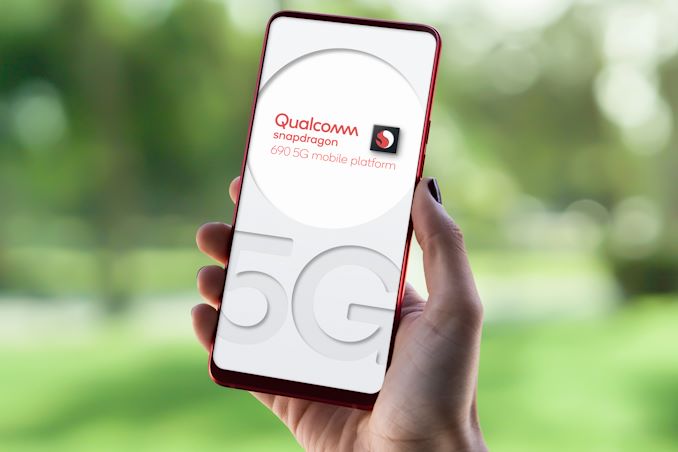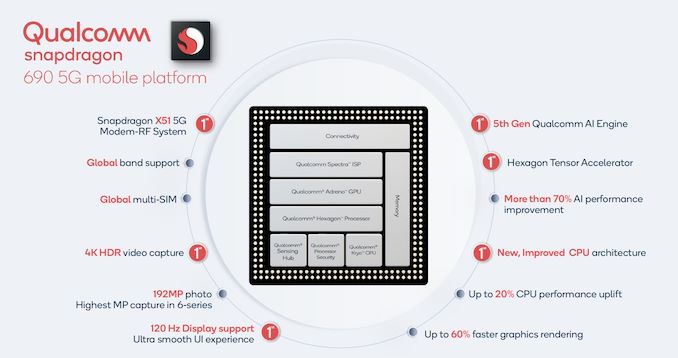Qualcomm Announces Snapdragon 690: 5G & A77 In The Mid-Range
by Andrei Frumusanu on June 16, 2020 10:00 PM EST- Posted in
- Mobile
- Qualcomm
- Smartphones
- SoCs
- Snapdragon 690

Today Qualcomm is extending its 5G SoC portfolio down to the Snapdragon 600-series, introducing the new Snapdragon 690 platform and chip. The new design is a more significant upgrade to the 600-series, not only upgrading the cellular capabilities, but also upgrading some of the cornerstone IPs to the newest generation available.
| Qualcomm Snapdragon 600-Range SoCs | |||||||
| SoC | Snapdragon 660 | Snapdragon 662 | Snapdragon 665 | Snapdragon 670 | Snapdragon 675 | Snapdragon 690 | |
| CPU | 4x Kryo 260 (CA73) @ 2.2GHz 4x Kryo 260 (CA53) @ 1.8GHz |
4x Kryo 260 (CA73) @ 2.0GHz 4x Kryo 260 (CA53) @ 1.8GHz |
4x Kryo 260 (CA73) @ 2.0GHz 4x Kryo 260 (CA53) @ 1.8GHz |
2x Kryo 360 (CA75) @ 2.0GHz 6x Kryo 360 (CA55) @ 1.7GHz |
2x Kryo 460 (CA76) @ 2.0GHz 6x Kryo 460 (CA55) @ 1.7GHz |
2x Kryo 560 (CA77) @ 2.0GHz 6x Kryo 560 (CA55) @ 1.7GHz |
|
| GPU | Adreno 512 | Adreno 610 | Adreno 615 | Adreno 612 | Adreno 619L | ||
| DSP | Hexagon 680 | Hexagon 683 | Hexagon 686 | Hexagon 686 | Hexagon 685 | Hexagon 692 |
|
| ISP/ Camera |
Spectra 160 24MP |
Spectra 340T 25MP single / 16MP dual |
Spectra 165 25MP single / 16MP dual |
Spectra 250 25MP single / 16MP dual |
Spectra 250 25MP single / 16MP dual |
Spectra 355L 48MP single / 32+16MP dual |
|
| Memory | 2x 16-bit @ 1866MHz LPDDR4 14.9GB/s |
2x 16-bit @ 1866MHz LPDDR4X 14.9GB/s 1MB system cache |
|||||
| Integrated Modem | Snapdragon X12 LTE | Snapdragon X11 LTE (Cat 12/13) DL = 390Mbps 2x20MHz CA, 256-QAM UL = 150Mbps 2x20MHz CA, 64-QAM |
Snapdragon X12 LTE (Category 12/13) DL = 600Mbps 3x20MHz CA, 256-QAM UL = 150Mbps 2x20MHz CA, 64-QAM |
Snapdragon X51 ( LTE ) DL = 1200 Mbps UL = 210 Mbps ( 5G NR Sub-6 ) DL = 2500 Mbps UL = 1200 Mbps |
|||
| Encode/ Decode |
2160p30, 1080p120 H.264 & H.265 |
1080p60 H.264 & H.265 |
2160p30, 1080p120 H.264 & H.265 |
||||
| Mfc. Process | 14nm LPP | 11nm LPP | 11nm LPP | 10nm LPP | 11nm LPP | 8nm LPP | |
Although the new Snapdragon 690 maintains its CPU configurations in terms of big and little cores in a 2+6 setup, Qualcomm has managed to include the newest Cortex-A77 IP for the big CPU cores, resulting in a 20% performance uplift thanks to the microarchitectural improvements. The clock speeds remain the same as found in other recent 600-series designs, meaning 2GHz on the big cores and 1.7GHz for the A55 cores.
On the GPU side, we see the shift to a new Adreno 619L design sees a much bigger shift with an up to 60% increase in performance compared to the previous generation Snapdragon 675.
Memory-wise, it’s still a LPDDR4X SoC with dual 16-bit channel support, which is plenty for the bandwidth requirements at this performance segment.
Qualcomm is also trickling down some of the newer higher end multimedia features to the 600-series, such as the newer generation Spectra iSP which is able to support up to 192MP still pictures or up to 48MP sensors with multi-frame noise reduction, or a dual-camera setup in tandem of 32+16MP sensors. The chip has a 10-bit capture and display pipeline, allowing it 4K HDR capture and display – although we didn’t see mention of 4K60 recording.
The key feature of the Snapdragon 690 is its shift towards a 5G modem platform. The integrated X51 modem now adds support for 5G sub-6GHz with global band support. The speeds here scale up to 2500Mbps downstream and 1200Mbps upstream on sub-6 networks, utilising up to 100MHz of spectrum bandwidth. The chip seemingly makes without mmWave connectivity, and this makes a lot of sense given the price range that the 600-series is meant to be used in, as well as the general lack of mmWave adoption in most markets.
“This new platform is designed to make 5G user experiences even more broadly available around the world. Snapdragon 690 also supports remarkable on-device AI and vibrant entertainment experiences. HMD Global, LG Electronics, Motorola, SHARP, TCL, and Wingtech are among the OEMs/ODMs expected to announce smartphones powered by Snapdragon 690.”
We’re expecting the new chip to be deployed in devices by various vendors in the second half of the year.











24 Comments
View All Comments
tkSteveFOX - Wednesday, June 17, 2020 - link
Just 2GHz 2xA77 cores and 1.7GHz 4xA55 - this isn't going to bring any performance improvements on the CPU side from SD765 (being clocked 2.2 on A76). More GPU is not what we is needed in this segment.yeeeeman - Wednesday, June 17, 2020 - link
It will because A77 has 20% higher IPC over A76, which more than makes up for the 200-300mhz deficit. In any case, SD690 should be an inferior product to SD765 but at it turns out it will the better one.isthisavailable - Wednesday, June 17, 2020 - link
A77 cores should come first to 700 series. They did the same thing with 675.Now we will have new, overpriced phones launching with 765 while some OEM's will have cheaper, better phones with 690 which does not make any sense at all.
dishayu - Wednesday, June 17, 2020 - link
That doesn't sound like a problem to me. You and i can just buy the cheaper, better phones.fmcjw - Wednesday, June 17, 2020 - link
Hopefully a back to basics model inspired by the success of the iPhone SE. The current crop of phones weighing 180 to 220 grams is unfortunate.Sharma_Ji - Wednesday, June 17, 2020 - link
Rendi note xx pro coming soon.TheProv - Wednesday, June 17, 2020 - link
I like these upper mid range SOCs a lot. Fairly modern architectures but not sky rocketing frequencies. Should have more than decent performance without crazy heath and power drain.eastcoast_pete - Wednesday, June 17, 2020 - link
Also, apparently fabbed by Samsung; unless TSMC has suddenly started 8 nm. I guess Samsung had plenty of cheaper capacity.Skifer - Wednesday, June 17, 2020 - link
As mediatek is pushing the performance envelope for upper and mid range SoCs with likes Dimenisty 820 and 1000 series, Qualcomm has to have better counter parts and give more boost to the performance of it 6xx and 7xx series of SoC to make a viable competitors, as we can clearly see they are currently lacking behind in comparison, all of themSD765, SD730, SD675, SD665 need big overhaul with CA77 and CA78 to keep up thier lead in the segment and more and considerinh the performance improvements shown by Mediatek more OEM's are preferring them for budget and mid range segment with P series, G series and Dimensity 820 and 1000 over the current line up of SD6xx or SD7xx series.patel21 - Thursday, June 18, 2020 - link
Yes Medeatek has started to provide some much needed competition android mobile segment needed. These new chips are fruit of it.I am quite interested in the Heat and Power consumption of this chip.